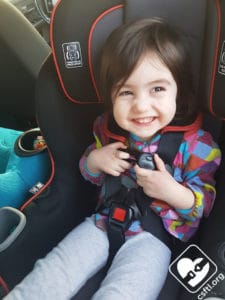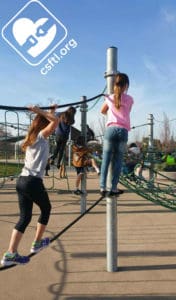At some point or another, every Little seems to test the boundaries when it comes to staying in their car seats. If you’ve got a little escape artist on your hands, we’ve got a few tips and tricks that can help keep them safe and secure while they’re on the road.
Check the Harness Fit
In some cases, a harness that doesn’t fit properly can introduce some slack or be quite uncomfortable and inspire them to try and escape.
Here are a few things to check:
- Rear facing car seats: Are the harness straps at or below the shoulders?
- Forward facing car seats: Are the harness straps at or above the shoulders?
- Tension: Are the straps snug enough to pass the pinch test without being overtightened? A harness that’s too snug or ill-fitting can inspire the most persistent escape artists to get to work!
- Bulky clothing: Was all bulky clothing removed before the child was harnessed in the seat?
Sometimes just a small adjustment to the harness can make a huge difference to the child’s comfort and reduce their desire to escape while they’re in their car seat.
Access to the Release Button
If the child is escaping by accessing the harness release button to loosen the straps, consider tucking a blanket or thin towel over that release button after the child is buckled into their seat.
If your child rides rear facing in a car seat that has a variety of allowable recline angles, sometimes installing the seat at a greater recline angle (as long as the seat allows it) can place that release button out of reach.
Offer Consequences and Rewards
Sometimes parenting strategies and car seats overlap. Here we offer a few behavior strategies to try with a child who is old enough (usually around 2 years old and older) to understand consequences. These options will not miraculously fix the problem overnight but need to be tried consistently and repetitively.
Trips as a Reward
Plan a special trip somewhere fun with your child — to a special playground, ice cream store, or other fun place — and let them know that they must leave their seat alone for the entire trip. If they play with their car seat during the trip, turn around and go home. This will likely take a few times for the point to get across; be patient!
Stickers or a Special Toy
Some children do better with a reward system: a sticker chart, an M&M, or a fruit snack may be good rewards for leaving the harness alone.
Set a timer (start with a short interval so that you are able to catch the child sitting properly and reinforce that behavior) and every time the child is able to leave their harness/chest clip alone for the entire length of time, they receive their special reward.
Always pair the reward with behavior-specific praise: “I love how you’re staying buckled safely.”
Repeat the process and the praise often. If this method works for your family, start lengthening the time on the timer until the child can go the entire ride without touching.
It is critical for the driver to keep their eyes on the road, and for any adults or other children to remain properly positioned, so options to consider include having someone sit next to the child handing the rewards, or pulling over to reward the child for a job well done.
Eventually, you will be able to phase the extra supports out, but giving verbal praise for remaining safely buckled is something that never need completely disappear.
Special Car-Only Toys/Books
Some kiddos just need something to distract them during the drive. A soft busy book or special toys that they only get in the car might be enough to distract them from trying to unbuckle.
Try a few different, novel items and rotate them regularly (don’t start with them all at once) so that the kiddos don’t get bored and try to unbuckle themselves.
Giving the Child More Responsibility
This approach tends to work better with the older crowd, but some children like having the responsibility of buckling up on their own or checking that everyone else is safely buckled before the vehicle moves.
If the child knows that everyone’s safety is their responsibility, they may rise to the challenge and become a proud CPS advocate. You can even give them a special name (“You’re our family safety officer!”) and proudly brag to others about their important job so they know it’s important too.
Button up Shirt Trick
We are often asked about this as a solution to children who are regularly escaping their harnessed seat. While it can be a valid solution, we want to caution parents and caregivers that this should only be tried when nothing else has worked, and should only be considered a temporary solution.
Step One: Dress the child in a t-shirt or long sleeved shirt and add an unbuttoned shirt over top.
Step Two: Harness the child properly. Place the chest clip at the child’s armpit level and make sure straps pass the pinch test.
Step Three: Button the shirt over the child and harness.
Note: This will only work with a child who cannot undo buttons. Children who can unbutton a shirt may escape from their car seat before their parents can buckle their seat belts!
Mittens
Mittens are another suggestion. Buckle the child into their seat and put the mittens on their hands.
Note: This will only work until the child figures out how to remove the mittens.
Other note: Do not use this technique in very hot weather!
Try a Different Car Seat
While changing car seats isn’t feasible for all caregivers, some models are more difficult for kids to manipulate than others.
We particularly like the chest clip on the Evenflo Titan 65 with Sensor Safe. Not only is the chest clip difficult to move up and down, but the seat comes equipped with an alarm that can notify parents and caregivers when the chest clip is unbuckled. We also are fans of the Maxi-Cosi magnetic chest clip (included on the Magellan Max and some other Maxi-Cosi convertible car seats). Note: this chest clip cannot be used if child/caregiver has an implanted electronic medical device; caregivers must contact Maxi-Cosi for a non-magnetic replacement in those cases.
Graco also will send a more tightly tensioned chest clip for some of their car seats upon request.
Contact a Special Needs Trained Child Passenger Safety Technician
Sometimes when there are special needs to take into consideration, meeting with a Special Needs trained CPST is the best course of action. They can help work with you to determine what is needed to keep your child safe, and keep you sane while driving them.
What About Booster Riders?
We advocate that children be at least 5 years old and mature enough to ride safely in a booster before moving from their harnessed car seats to a booster seat. When a 5 or 6 year old unbuckles or plays with the vehicle seat belt while the vehicle is in motion, they may not be mature enough for the responsibility of a booster seat just yet.
For older children, sobering videos of what happens when a person is not buckled correctly can be enough to help them understand how their behavior affects their safety.
Staying Safe
While there is no one-size-fits-all solution for car seat escape artists, with consistency and patience (and a little ingenuity!) it’s possible to safely overcome this challenging phase.






